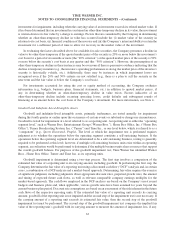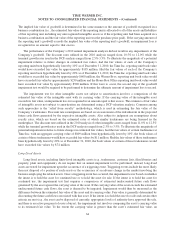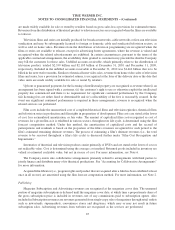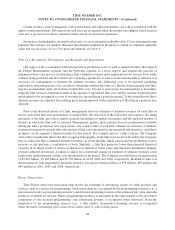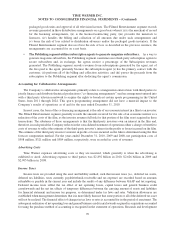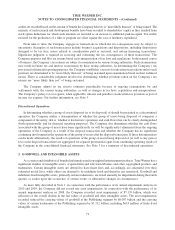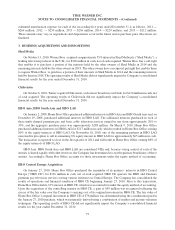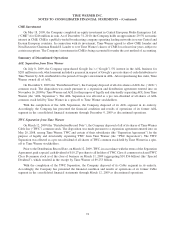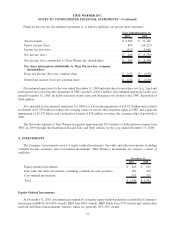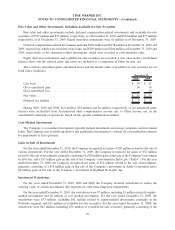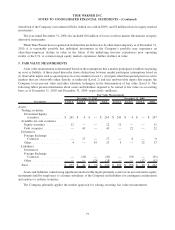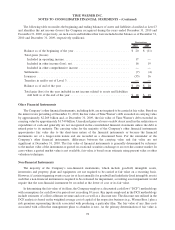Time Magazine 2010 Annual Report Download - page 82
Download and view the complete annual report
Please find page 82 of the 2010 Time Magazine annual report below. You can navigate through the pages in the report by either clicking on the pages listed below, or by using the keyword search tool below to find specific information within the annual report.packaged goods units and approval of all television licenses. The Filmed Entertainment segment records
revenue generated in these distribution arrangements on a gross basis when it (i) is the merchant of record
for the licensing arrangements, (ii) is the licensor/contracting party, (iii) provides the materials to
licensees, (iv) handles the billing and collection of all amounts due under such arrangements and
(v) bears the risk of loss related to distribution advances and/or the packaged goods inventory. If the
Filmed Entertainment segment does not bear the risk of loss as described in the previous sentence, the
arrangements are accounted for on a net basis.
•The Publishing segment utilizes subscription agents to generate magazine subscribers. As a way to
generate magazine subscribers, the Publishing segment sometimes uses third-party subscription agents to
secure subscribers and, in exchange, the agents receive a percentage of the Subscription revenues
generated. The Publishing segment records revenues from subscriptions generated by the agent, net of
the fees paid to the agent, primarily because the subscription agent (i) has the primary contact with the
customer, (ii) performs all of the billing and collection activities, and (iii) passes the proceeds from the
subscription to the Publishing segment after deducting the agent’s commission.
Accounting for Collaborative Arrangements
The Company’s collaborative arrangements primarily relate to arrangements entered into with third parties to
jointly finance and distribute theatrical productions (“co-financing arrangements”) and an arrangement entered into
with a third party television network to acquire the rights to broadcast certain sports programming in the United
States from 2011 through 2024. This sports programming arrangement did not have a material impact to the
Company’s results of operations as of and for the year ended December 31, 2010.
In most cases, the form of the co-financing arrangement is the sale of an economic interest in a film to an investor.
The Filmed Entertainment segment generally records the amounts received for the sale of an economic interest as a
reduction of the costs of the film, as the investor assumes full risk for that portion of the film asset acquired in these
transactions. The substance of these arrangements is that the third-party investors own an interest in the film and,
therefore, in each period the Company reflects in the consolidated statement of operations either a charge or benefit to
costs of revenue to reflect the estimate of the third-party investor’s interest in the profits or losses incurred on the film.
The estimate of the third-party investor’s interest in profits or losses incurred on the film is determined using the film
forecast computation method. For the years ended December 31, 2010, 2009 and 2008, net participation costs of
$508 million, $321 million and $584 million, respectively, were recorded in costs of revenues.
Advertising Costs
Time Warner expenses advertising costs as they are incurred, which generally is when the advertising is
exhibited or aired. Advertising expense to third parties was $2.892 billion in 2010, $2.626 billion in 2009 and
$2.905 billion in 2008.
Income Taxes
Income taxes are provided using the asset and liability method, such that income taxes (i.e., deferred tax assets,
deferred tax liabilities, taxes currently payable/refunds receivable and tax expense) are recorded based on amounts
refundable or payable in the current year and include the results of any difference between GAAP and tax reporting.
Deferred income taxes reflect the tax effect of net operating losses, capital losses and general business credit
carryforwards and the net tax effects of temporary differences between the carrying amount of assets and liabilities
for financial statement and income tax purposes, as determined under tax laws and rates. Valuation allowances are
established when management determines that it is more likely than not that some portion or all of the deferred tax asset
will not be realized. The financial effect of changes in tax laws or rates is accounted for in the period of enactment. The
subsequent realization of net operating loss and general business credit carryforwards acquired in acquisitions accounted
for using the purchase method of accounting is recognized in the statement of operations. Research and development
70
TIME WARNER INC.
NOTES TO CONSOLIDATED FINANCIAL STATEMENTS – (Continued)





